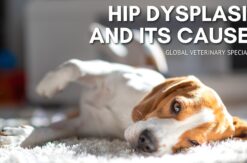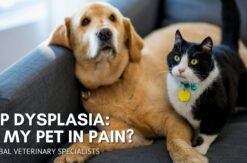Treatment for hip dysplasia depends on the condition’s severity and your pet’s overall health. Typically, conservative treatment options such as pain management and exercise modifications are attempted before a board-certified veterinary surgeon will recommend a total hip replacement (THR), particularly for dogs and cats with mild HD whose symptoms have not progressed to the extent they impact quality of life.
A common concern with conservative options is the cost of pain management. The cost of administering non-steroidal anti-inflammatory drugs (NSAIDs), opiate-derivates, or both should be considered as they can accumulate rapidly with long-term use. Over time, these costs often far exceed the price of surgical intervention, which restores a pain-free joint rather than merely masks the symptoms.
Symptoms include but may not be limited to weight shifting, bunny hop gait, premature tiring during exercise, difficulty standing or sitting, mild limp when rising after rest, and hesitance to jump or climb stairs. Your pet may also appear uninterested in doing the activities they once loved.
Animals who present with moderate or severe cases, or with arthritis secondary to hip dysplasia, will likely require surgical intervention once skeletal maturity has been reached. Additional indications for surgery include hip luxation, avascular necrosis of the femoral head, and specific hip fractures. A total hip replacement (THR) is an effective treatment option as it allows your pet to go on to live an healthy and happy life.
A Closer Look at Total Hip Replacement Surgery
In a total hip replacement (THR), a board-certified veterinary surgeon replaces the femoral head (ball), femoral stem, and acetabulum (socket) with prosthetic components manufactured using the exact strict THR specifications as those made for humans. The wear properties are superb for cats and dogs that distribute weight on all four legs, and its durability is good for the lifetime of your pet.
The femoral stem and metal shell of the cup are composed of titanium with a porous surface that is 65 percent space, enabling bone growth – a process called osseointegration, and 35 percent metal. Titanium is tolerated well by the body and has a desirable modulus of elasticity, yield strength, fatigue strength, mass density, and ultimate strength for indefinite durability. It also offers excellent corrosion resistance.
The femoral head, also known as the “ball,” is made of cobalt chrome and has a polished surface in the sub-micron range to minimize long-term wear. The most prominent head is made up of ultra-high molecular weight polyethylene. That is a highly durable material that contacts the head, allowing for an unhindered range of motion of the joint during everyday activities like walking or running.
Each component of the prosthetic device is available in various sizes that can be mixed and matched to custom fit each patient animal. They are further divided into cemented and cementless, determined during a comprehensive examination with a veterinary specialist, and dependent on several factors, including the severity of the condition and duration of their arthritis secondary to hip dysplasia.
Schedule a Veterinary Specialist Appointment Today
Global Veterinary Specialists recognize that dogs and cats encounter orthopedic injuries, disabling difficulties, and diseases that can impact their quality of life and are committed to restoring pain-free mobility by treating hip dysplasia and other conditions. Each board-certified veterinary surgeon has more than twenty years of veterinarian and surgical experience, so you can be assured your pet is in the best of hands.
We are teachers, mentors, inventors, clinical researchers, and veterinary surgeons committed to achieving excellent results for every patient animal we see regardless of their age or breed. We invite you to contact us today to learn about the various options for correcting hip dysplasia and how we can help restore your pet’s quality of life.



